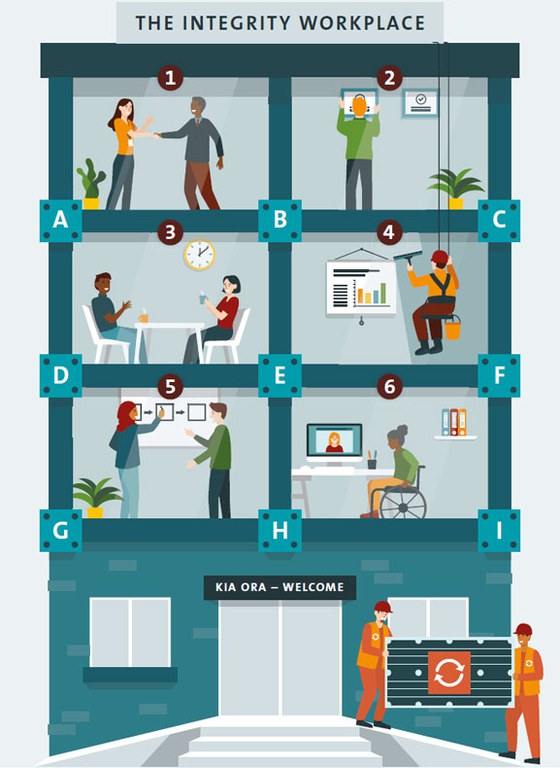Introducing the integrity framework
Please note: There is an updated version of this framework.
At its simplest, the framework aims to reduce any integrity gap
The integrity framework (the framework) aims to reduce the gap between the culture an organisation wants to have and its actual practice.
Research has found that:
…the most effective strategy to embed a culture of integrity within the organisation is to combine compliance instruments to control unethical behaviour with an integrity approach to stimulate ethical behaviour.18
And, importantly:
This requires time and reinforcement through multiple parts of the organisation to make it an integral part of the day-to-day decisions, staff behaviours, and the operating environment.19
The framework set out here is an integrated approach to examining the values, systems, and norms in a workplace. It's about identifying the key activities and ways of working that help to build and sustain integrity across the whole organisation. All the components that follow are required and need to reinforce each other. They should be explicitly designed and monitored as a coherent system of improvement.
The framework is made up of three components
The framework starts with six ways of working. The ways of working represent how a public organisation can go about doing the work of building integrity. The ways of working shift the focus from simply improving control systems and requiring compliance to building an organisation that has integrity in all the ways it operates.
Integrity is not a once-a-year wonder. It needs to continue to be delivered over the course of the year. Don’t only deliver messaging on integrity because of there being a problem. It needs to become a routine of the organisation.”
Government department integrity specialist
Part 3 sets out the six ways of working in more detail.
The nine building blocks of the framework are what a public organisation should have in place. They are the key intervention points or activities that, when connected and build on one another, lead to the best results in strengthening an organisation's integrity system. When working on the building blocks, it is essential to also embed the ways of working. Part 4 sets out more information about the nine building blocks.
We expect most public organisations will already have all or most of the building blocks in place. However, building and maintaining integrity is an ongoing process.
For this reason, the final component of the integrity framework is continuous improvement. Integrity is not a destination; it is a process whereby an organisation continually looks for ways to do better.
We share where there are lessons for the organisation. It’s great to be able to use things that have happened to educate.”
Government department manager
Organisational memory is an essential factor in continuous learning and improvement. Using an organisation's accumulated body of data, information, and knowledge can ensure that new initiatives or changes build on previous experience and do not repeat previous mistakes.
The culture of an organisation will also change and evolve in response to changing circumstances or work pressures. Policies and practices need to be regularly reviewed, lessons need to be learned and fed back into systems improvements, and changes need to be communicated to ensure transparency and accountability.
Work on integrity should not be seen as a one-off initiative. And no single component will drive the improvements in organisational integrity necessary to prevent poor conduct and behaviour. We encourage public organisations to adopt and adapt all the components of this framework for their own unique environment and keep reviewing progress toward embedding integrity into everyday practice.
Figure 1
The integrity framework

The three components of the framework
The ways of working
 |
Ongoing commitment |  |
Build alignment |
 |
Prioritise relationships |  |
Provide transparency |
 |
Make it easy |  |
Be inclusive |
The building blocks
Continuous improvement |
 |
18: Bushell, J, Cain, C, Duncan, L-A and Lasthuizen, K (2021), HUMANGOOD: A field guide to ethical leadership, Brian Picot Chair in Ethical Leadership Aritahi, Wellington School of Business and Government Ōrauariki, page 81.
19: Bushell, J, Cain, C, Duncan, L-A and Lasthuizen, K (2021), HUMANGOOD: A field guide to ethical leadership, Brian Picot Chair in Ethical Leadership Aritahi, Wellington School of Business and Government Ōrauariki, page 81.










